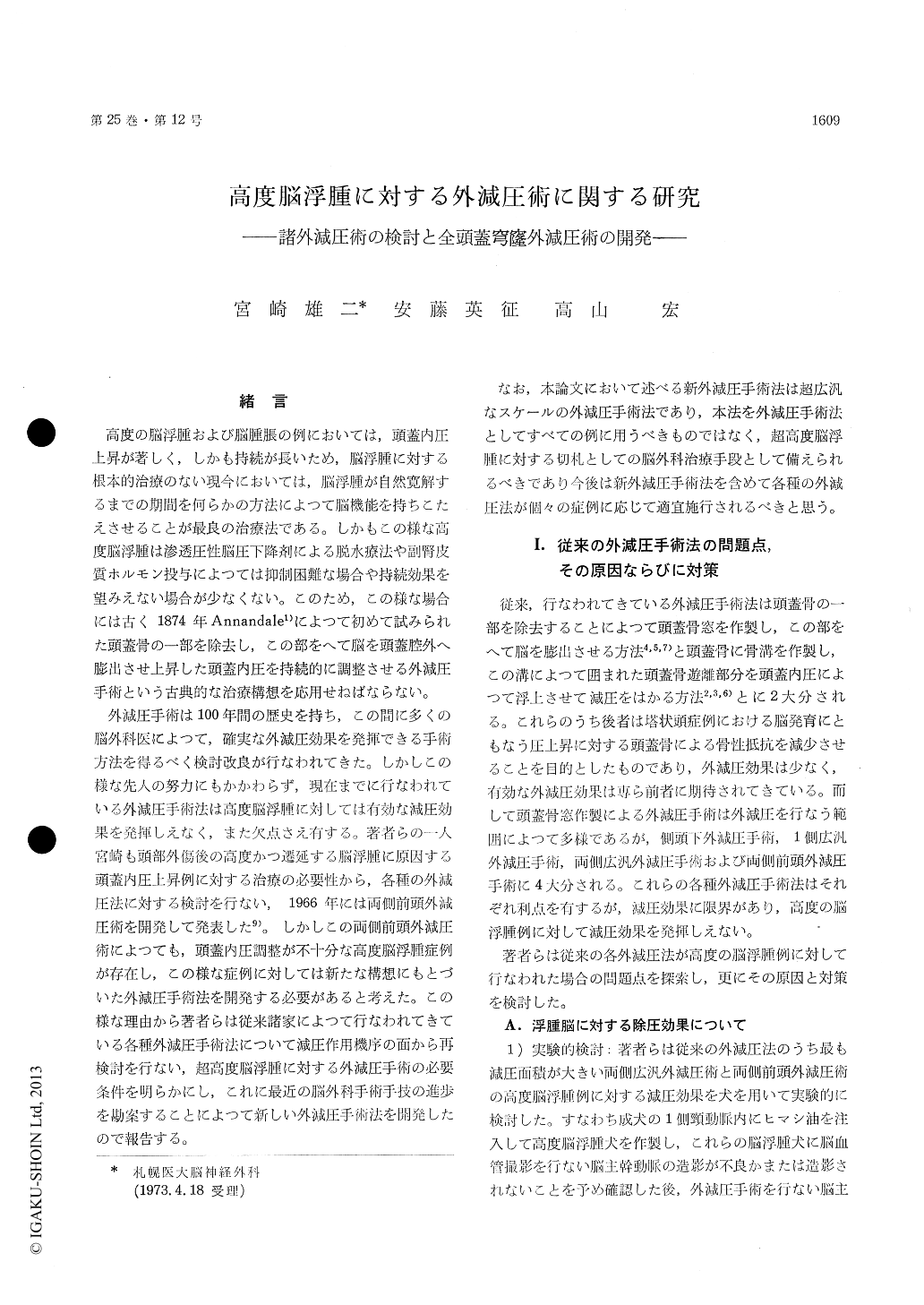Japanese
English
- 有料閲覧
- Abstract 文献概要
- 1ページ目 Look Inside
緒言
高度の脳浮腫および脳腫脹の例においては,頭蓋内圧上昇が著しく,しかも持続が長いため,脳浮腫に対する根本的治療のない現今においては,脳浮腫が自然寛解するまでの期間を何らかの方法によつて脳機能を持ちこたえさせることが最良の治療法である。しかもこの様な高度脳浮腫は滲透圧性脳圧下降剤による脱水療法や副腎皮質ホルモン投与によつては抑制困難な場合や持続効果を望みえない場合が少なくない。このため,この様な場合には古く1874年Annandale1)によつて初めて試みられた頭蓋骨の一部を除去し,この部をへて脳を頭蓋腔外へ膨出させ上昇した頭蓋内圧を持続的に調整させる外減圧手術という古典的な治療構想を応用せねばならない。
外減圧手術は100年間の歴史を持ち,この間に多くの脳外科医によつて,確実な外減圧効果を発揮できる手術方法を得るべく検討改良が行なわれてきた。しかしこの様な先人の努力にもかかわらず,現在までに行なわれている外減圧手術法は高度脳浮腫に対しては有効な減圧効果を発揮しえなく,また欠点さえ有する。著者らの一人宮崎も頭部外傷後の高度かつ遷延する脳浮腫に原因する頭蓋内圧上昇例に対する治療の必要性から,各種の外減圧法に対する検討を行ない,1966年には両側前頭外減圧術を開発して発表した9)。しかしこの両側前頭外減圧術によつても,頭蓋内圧調整が不十分な高度脳浮腫症例が存在し,この様な症例に対しては新たな構想にもとづいた外減圧手術法を開発する必要があると考えた。この様な理由から著者らは従来諸家によつて行なわれてきている各種外減圧手術法について減圧作用機序の面から再検討を行ない,超高度脳浮腫に対する外減圧手術の必要条件を明らかにし,これに最近の脳外科手術手技の進歩を勘案することによつて新しい外減圧手術法を開発したので報告する。
In the external decompressive operations used hitherto, the decompressive effect in highly severe brain edema cases could not be realized and in such cases an external decompressive operation with a stronger effect was in demand.
The authors conducted experimental and clinical investigations from a point of view the mechanism of decompression of the brain to review the dis-advantage of external decompressive operation used hitherto. And as result the necessary condi-tions for external decompressive operation leading to maximal decompressive effects from an anatomi-cal point of view were clarified. Based on these findings an new external decompressive operation involving total calvarium removal was developed. The authors named "total calvarial external de-compression.
The new technique is as follow ; The skin in-cision is made between the immediate front of the auricle across the midpoint of midline coronally.
The total calvarium is removed in two bone flaps, frontal and parietooccipital flap. The dura mater is incised 2cm. above the edge of craniotomy line and excluding the posterior end of superior sagittal sinus. The dural graft (pericranium or lyophilized dura mater) is transplanted in the dural defect made by strongly swelling of the brain. Since parietooccipital portion of the skull which shows extreme protrusion and convexity has been removed, there is ample reserve of the scalp and even when a highly intense brain swelling is present the scalp will completely cover the whole part of brain.
The authors have conducted this new decom-pressive operation in 6 clinical cases. All cases showed intense brain edemas as results of head injuries. Moreover in all cases the cerebrospinal fluid pressure was over 500mmH2O and conscious-ness state was comatose, in addition in these cases showing unilateral or bilateral fixed pupil and decerebrate rigidity. Out of these six cases two lives were saved. In the cases in the preoperative angiogram, nonfilling of main cerebral arteries is proved, immediately after operation the main cere-bral arteries are visible.
The following 8 points are the characteristic advantages of the total calvarial external decom-pressive operation.
1. The operation allows for a sufficient reserve space for brain edema.
2. The brain retains its normal shape and is allowed to swell.
3. The various portions of the brain maintain their relative positions.
4. A lack in unevenness of pressure between the various portions of the brain is seen.
5. No damage is sustained by the brain tissue.
6. No torn of the bridging veins by remarkable swelling of brain is seen.
7. The cerebellar tentorium may be further incised, if required.
8. Observation and dealing with the total cerebral hemisphere is possible.

Copyright © 1973, Igaku-Shoin Ltd. All rights reserved.


